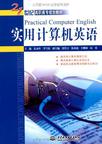实用计算机英语
2009-8
水利水电出版社
夏永恒,李雪松 主编
294
计算机技术作为一项时代性科技,其飞速的革新变化需要有强烈的创新力量来支持。随着越来越多的计算机新技术的运用,计算机专业人员需要有良好的专业英语水平来及时了解并掌握技术发展的新动向。 本书针对计算机应用及相关专业高职高专院校学生的学习水平、能力和计算机实践需要,通过创新的教材编写形式使学生掌握计算机专业英语的基础知识和最新技术,提高计算机综合运用水平。 本书编写的主要特点是所有的文章均为科技类,不仅知识内容丰富,并且针对高职高专教学特点,做到了深入浅出,通俗易懂。每一章节除了正文外,还增加了对话练习、热身训练、附加阅读、练习题四个方面的内容。通过互动形式,进一步开拓学生的听、说、读、写能力,丰富了教学手段。尤其是附加阅读内容时效性、专业性强,既可以作为教师的课堂讲述内容,也适合学生作为补充材料阅读。此外,书中还配以大量的教学图例,使学生能够直观、简明地了解学习内容,增强实操能力。书后附有所有文章的参考译文,以及附录词汇表,包括专业词汇、词组以及专业缩略词的部分音标和解释,方便教师和学生查阅使用(由于篇幅有限,参考译文请登录中国水利水电出版社网站或万水书苑免费下载。 本书共分9章,为了方便教师安排教学计划,每章分为4小节,每一小节都是完整独立的。第1章计算机基础,作为一个概要统领全书内容,介绍了计算机硬件、软件、基本的算法结构和网络方面的基础知识。第2章操作系统,介绍了操作系统的基本原理和功能的相关知识以及时下流行的一些操作系统的特点、种类等,尤其是对Linux做了着重说明。第3章数据库,介绍了数据库系统的基本原理,结构化查询语言以及数据仓库的相关概念。第4章多媒体,介绍了多媒体并行处理技术,Photoshop以及计算机动画制作相关的历史和技术。第5章计算机语言,介绍了计算机常用的程序设计语言及其算法知识。第6章计算机网络,介绍了计算机网络设备、协议和结构等方面的基础原理和架构。以最新的Web 2.0为例详解了计算机网络以及相关协议的实践应用。第7章网络安全,介绍了计算机网络安全的主要隐患和防范方法,对现今最受瞩目的计算机病毒和网络防火墙做了详尽地介绍。第8章互联网与电子商务,介绍分析了互联网和电子商务的基础原理。第9章软件工程,介绍了软件工程基础和软件开发实践中生命模型原理和实践分析。
本书大部分内容都和日常使用的计算机密切相关,实用性强。书中内容有的是从一些计算机设备说明书中摘录的,有的是从软件使用手册或帮助中精选的,甚至有些内容是从软件的界面上选取的。通过学习本书可以在将来更好地理解计算机相关设备的使用和软件的操作等。此外,本书还增加了对话内容,让读者在学习计算机英语知识的同时,还可以了解在面试求职、产品讨论等方面计算机类英语口语的表达。每节设有“Warm-up”部分,通过提出问题让读者在阅读本书时有一定的目的性,并给本节内容做一个铺垫。 本书主要适合高职高专类计算机相关专业的学生使用,同时也可作为本科类专业的辅助教材,还可以作为计算机类相关职业培训的教材。
前言Chapter 1 Computer Fundamentals Section 1 Computer Hardware Dialogue Warm-up Text Exercises Reading 1 Reading 2 Section 2 Computer Software and Categories Dialogue Warm-up Text Exercises Reading 1 Reading 2 Section 3 Data Structure and Algorithms Dialogue Warm-up Text Exercises Reading 1 Section 4 Computer Networks Dialogue Warm-up Text Exercises Reading 1 Reading 2Chapter 2 Operating System Section 1 Introduction to Operating System Dialogue Warm-up Text Exercises Reading 1 Section 2 Functions of Operating System Dialogue Warm-up Text Exercises Reading 1 Reading 2 Section 3 Popular Operating Systems and Structures Dialogue Warm-up Text Exercises Reading 1 Reading 2 Section 4 Linux and Networking Operating System Dialogue Warm-up Text Exercises Reading 1Chapter 3 Database Section 1 Parts of a Database Dialogue Warm-up Text Exercises Reading 1 Reading 2 Section 2 Relational Database Components Dialogue Warm-up Text Exercises Reading 1 Reading 2 Section 3 Database Architecture Dialogue Warm-up Text Exercises Reading 1 Reading 2 Section 4 Data Warehouses Overview Dialogue Warm-up Text Exercises Reading 1 Reading 2Chapter 4 Multi Media Section 1 About Masks and Alpha Channels.. Dialogue Warm-up Text Exercise Reading 1 Reading 2 Section 2 Main File Formats in Photoshop Dialogue Warm-up Text Exercise Reading 1 Reading 2 Section 3 Computer Animation Dialogue Warm-up Text Exercise Reading 1 Reading 2 Section 4 Creating Your Own Web Page Graphics Dialogue Warm-up Text Exercise Reading 1 Reading 2Chapter 5 Programming Language Section 1 Introduction to Programming Language Dialogue Wan a-up Text Exer rises Reacing 1 Reacing 2 Section 2 Procedural Programming Dialogue Warm-up Text Exercises Reading 1 Reading 2 Reading 3 Section 3 Java Programming Language Dialogue Warm-up Text Exercises Reading 1 Reading 2 Reading 3 Section 4 .NET Framework Dialogue Warm-up Text Exercises Reading 1Chapter 6 Computer Network Section 1 Network Devices Dialogue Warm-up Text Exercises Reading 1 Reading 2 Section 2 Network Protocol Dialogue Warm-up Text Exercises Reading 1 Section 3 Network Architecture Dialogue Warm-up Text Exercises Reading 1 Reading 2 Section 4 Web 2.0 Dialogue Warm-up Text Exercises Reading 1 Reading 2Chapter 7 Network Scurity Section 1 Security Attack Dialogue Warm-up Text Exercises Reading 1 Section 2 Model for Network Security Dialogue Warm-up Text Exercises Reading 1 Section 3 Malicious Programs Dialogue Warm-up Text Exercises Reading 1 Section 4 Security Services Dialogue Warm-up Text Exercises Reading 1Chapter 8 Internet and E-commerce Section 1 Internet Dialogue Warm-up Text Exercise Reading 1 Section 2 E-commerce Dialogue Warm-up Text Exercise Reading 1 Section 3 E-commerce Careers Dialogue Warm-up Text Exercise Reading 1 Section 4 E-commerce--How It Works Dialogue Warm-up Text Exercise Reading 1Chapter 9 Software Engineering Section 1 Why Software Engineering? Dialogue Warm-up Text Exercises Reading 1 Section 2 Modeling the Process Life Cycle Dialogue Warm-up Text Exercises Reading 1 Reading 2GlossaryComputer TermsAbbreviationsBibliography
Multi-Core Processing In 1965, when he first set out what we now call Moores Law, Gordon Moore (who laterco-founded Intel Corp.) said the number of components that could be packed onto an integratedcircuit would double every year or so (later amended to 18 months). In 1971, Intels 4004 CPU had 2,300 transistors. In 1982, the 80286 debuted with 134,000transistors. Now, run-of-the-mill CPUs count upward of 200 million transistors, and Intel isscheduled to release a processor with 1.7 billion transistors for later this year. For years, such progress in CPUs was clearly predictable: successive generations of semiconductortechnology gave us bigger, more powerful processors on ever-thinner silicon substrates operating atincreasing clock speeds. These smaller, faster transistors use less electricity, too. But theres a catch. It turns out that as operating voltages get lower, a significant amount ofelectricity simply leaks away and ends up generating excessive heat, requiring much more attentionto processor cooling and limiting the potential speed advance——think of this as a thermal barrier. To break through that barrier, processor makers are adopting a new strategy, packing two or morecomplete, independent processor cores, or CPUs, onto a single chip. This multi-core processor plugsdirectly into a single socket on the motherboard, and the operating system sees each of the executioncores as a discrete logical processor that is independently controllable. Having two separate CPUsallows each one to run somewhat slower, and thus cooler, and still improve overall throughput forthe machine in most cases. From one perspective, this is merely an extension of the design thinking that has for several yearsgiven us n-way servers using two or more standard CPUs; were simply making the packagingsmaller and the integration more complete. In practice, however, this multi-core strategy represents amajor shift in processor architecture that will quickly pervade the computing industry. Having twoCPUs on the same chip rather than plugged into two separate sockets greatly speeds communicationbetween them and cuts waiting time. The first multi-core CPU from Intel is already on the market. By the end of 2006, Intel expectsmulti-core processors to make up 40% of new desktops, 70% of mobile CPUs and a whopping 85%of all server processors that it ships. Intel has said that all of its future CPU designs will bemulti-core. Intels major competitors——including Advanced Micro Devices Inc., Sun MicrosystemsInc. and IBM——each appear to be betting the farm on multi-core processors.
超实用计算机情景口语、精选最新计算机英语时文、紧扣职业技能要求拓展专业知识。
